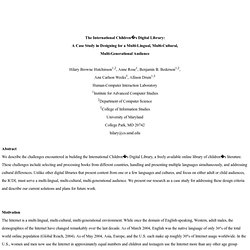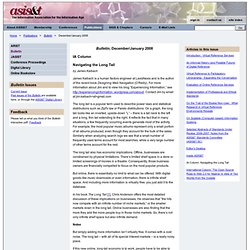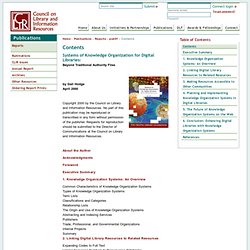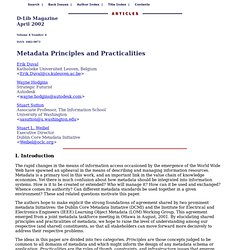

Metadata Harvesting and the Open Archives Initiative. Digital Libraries: Metadata's Bitter Harvest. Dublin Core Metadata Harvested Through OAI-PMH. Open Archives Forum - OAI-PMH Online Tutorial. This tutorial is an introduction to the Open Archives Initiative Protocol for Metadata Harvesting (OAI-PMH). Working through this tutorial you will: gain an overview of the history behind the OAI-PMH and an overview of its key features; achieve a deeper technical insight into how the protocol works; learn something about some of the main implementation issues; find some useful starting points and hints that will help you as an implementer.
The Overview, History and Development of OAI-PMH, and Glossary may be used on their own to gain information about OAI and OAI-PMH without going into technical implementation details. This Tutorial is originally written in English language. Translations into other languages are intended. If you are interested to engage yourself for a translation into your own language please contact: contact@oaforum.org. Search and Retrieval in The European Library: A New Approach. Abstract The objective of the European Library (TEL) project [TEL] was to set up a co-operative framework and specify a system for integrated access to the major collections of the European national libraries.

This has been achieved by successfully applying a new approach for search and retrieval via URLs (SRU) [ZiNG] combined with a new metadata paradigm. One aim of the TEL approach is to have a low barrier of entry into TEL, and this has driven our choice for the technical solution described here. The solution comprises portal and client functionality running completely in the browser, resulting in a low implementation barrier and maximum scalability, as well as giving users control over the search interface and what collections to search. In this article we will describe, step by step, the development of both the search and retrieval architecture and the metadata infrastructure in the European Library project. 1. Introduction to metadata harvesting. Bates. Guidelines for implementing DC in XML.
1.

Introduction This document provides guidelines for people implementing Dublin Core [DCMI] metadata applications using XML [XML]. It considers both simple (unqualified) DC and qualified DC applications. In each case, the underlying metadata model is described (in a syntax neutral way), followed by some specific guidelines for XML implementations. Some guidance on the use of non-DC metadata is also provided. This document does not provide guidelines for encoding Dublin Core in RDF/XML [RDF]. 2.
Resource a resource is anything that has identity. Property a property is a specific aspect, characteristic, attribute, or relation used to describe a resource. Record. The International Children s Digital Library: The International Childrens Digital Library: A Case Study in Designing for a Multi-Lingual, Multi-Cultural, Multi-Generational Audience Hilary Browne Hutchinson1,2, Anne Rose1, Benjamin B.

Bederson1,2, Ann Carlson Weeks3, 1,3 Human-Computer Interaction Laboratory 1Institute for Advanced Computer Studies. Bulletin December/January 2008. IA Column Navigating the Long Tail by James Kalbach James Kalbach is a human factors engineer at LexisNexis and is the author of the recent book Designing Web Navigation (O’Reilly).

For more information about Jim and to view his blog “Experiencing Information,” see .wordpress.com/about/. Contact Jim by email at jim.kalbach<at>gmail.com The long tail is a popular term used to describe power laws and statistical distributions such as Zipf's law or Pareto distributions. The long tail also has economic implications. But online, there is essentially no limit to what can be offered. In his book The Long Tail [1], Chris Anderson offers the most detailed discussion of these implications on businesses. Noise But simply adding more information isn’t virtually free. If this new online, long-tail economy is to work, people have to be able to navigate to the markets that interest them and filter the information quickly and efficiently.
The Navigation Layer. Contents. Systems of Knowledge Organization for Digital Libraries: Beyond Traditional Authority Files.

Elings. Metadata Principles and Practicalities. I.

Introduction The rapid changes in the means of information access occasioned by the emergence of the World Wide Web have spawned an upheaval in the means of describing and managing information resources. Metadata is a primary tool in this work, and an important link in the value chain of knowledge economies. Yet there is much confusion about how metadata should be integrated into information systems. How is it to be created or extended? The authors hope to make explicit the strong foundations of agreement shared by two prominent metadata Initiatives: the Dublin Core Metadata Initiative (DCMI) and the Institute for Electrical and Electronics Engineers (IEEE) Learning Object Metadata (LOM) Working Group.
The ideas in this paper are divided into two categories. II. A. Metadata modularity is a key organizing principle for environments characterized by vastly diverse sources of content, styles of content management, and approaches to resource description. B. C. 21st Century Description and Access. Many recent articles, reports, and presentations in the library profession have identified major environmental, technological, and philosophical changes that are requiring us to completely rethink how libraries perform bibliographic control.1 Even the term bibliographic control is an anachronism: Bibliographic: This term has a lot to do with published literature – mainly book literature but to some extent also journal–, but not much at all to do with many of the forms of communication now being used on the Internet.

When we harvest web sites, what is the part that we can call bibliographic? How bibliographic is, for example, a collaborative blog? We desperately need a more general and generic term for this, which for lack of a better idea I've decided to select descriptive, since no matter what the resource we are basically talking about describing a resource. Library 2.0 Theory: Web 2.0 and Its Implications for Libraries. Jack M.

Maness MLS, University of Colorado at Boulder Libraries, 1720 Pleasant St., Boulder, CO, USA. Email: jack dot maness at colorado dot edu Received June 19, 2006; Accepted June 29, 2006.